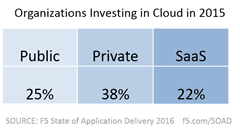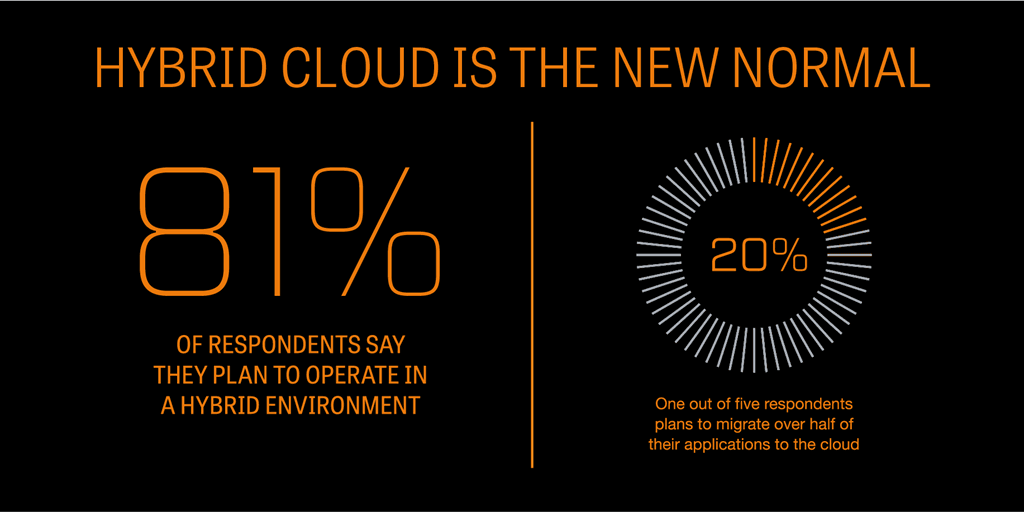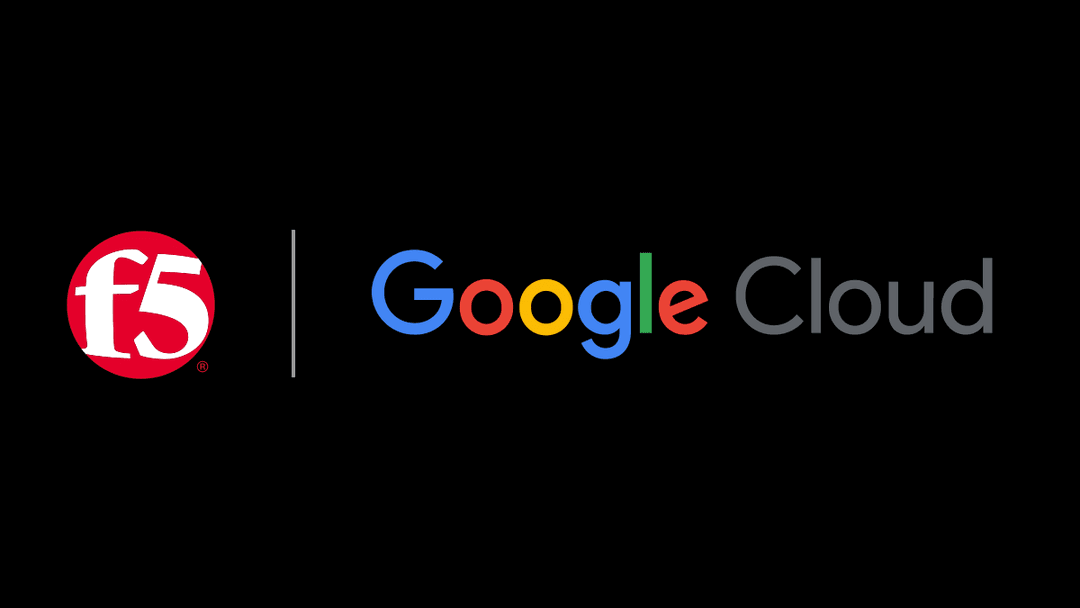Cloud. You can’t go anywhere these days without seeing something related to cloud. Even my eight-year old knows all about it. It’s where he puts all the stuff on his iPod when he runs out of space locally, dontcha know.
But aside from the sometimes inappropriate use of the term in apps and ads and marketing, cloud is a reality for every organization today. Complicating matters is the parallel reality that on-premises is not going away, either. Which is how we arrived at our “hybrid is the new normal” finding in our 2016 State of Application Delivery report.
Now we can argue about the definition of “hybrid” and whether it’s more appropriate to say “multi-cloud” when we’re not talking about app architectures that span multiple cloud providers or whether the term “hybrid” has any more meaning than “cloud” did six or so years ago. Regardless of what we want to call it, it’s a given that organizations today employ a healthy mixture of IaaS, SaaS, and traditional on-premises environments in order to deliver the apps that support the productivity and profit goals of the business. In fact, only 19% of respondents claim they aren’t planning on such a mixed, hybrid environment and 67% tell us they’re a “cloud first” organization.

That’s more than just pie-in-the-sky talk. When we dug into organizations’ spending in 2015, private cloud and SaaS both made the top five, with private cloud leading the way. Only mobile managed to match that, with 38% having spent some of their limited budget resources on the technology.
And with the distribution of apps across such varied environments come challenges, especially those related to security. A surprising 22% of respondents told us they had no challenges with hybrid cloud. If you’re one of those 22%, I’m guessing the majority of orgs who indicated comprehensive analytics (29%), id and access management (29%), and data security (17%) would like you to divulge your secrets.
Still, organizations seem to be addressing the challenges the majority are facing with hybrid environments. The fastest growing app services – those organizations plan to deploy in the next 12 months – are all tied to or useful in implementing hybrid and cloud environments.

Tied for the top spot with DNSSEC (26%) was identity federation services (26%). These app services are invaluable to organizations that need to govern access to cloud-deployed applications and, in particular, SaaS applications. The big boon here is that most ID Federation services are able to support both on-premises (traditional and cloud) as well as off-premises (cloud and SaaS) applications, neatly offering an answer to the comprehensive identity and access challenge cited by respondents with respect to hybrid cloud. Similarly, the intentions of 24% to deploy SSO services points to the desire by organizations (and consumers) to literally get a handle on managing identity across the growing number of apps employees need to access every day, both on-premises and in the cloud.
But it’s not just security and app services that are impacted by the fog of cloud descending on organizations. The relevance of SDN and DevOps, too, seem to be tied to organizations’ strategic view of cloud – and whether it’s public or private.
We found a much stronger tie between those who view private cloud strategic and similar ratings for DevOps than there is for public cloud. Which on the surface seems to defy the market’s desire to bind public cloud and DevOps together. But given the fact that a private cloud must be built from the ground up, and include automation of everything from layer 2 to layer 7, this relationship isn’t as far-fetched as it first seems. DevOps is definitely one of the ways in which an organization can build and sustain the lean and efficient operational model it needs to support something as “service” oriented as a private cloud.
In any case, application delivery is certainly becoming very cloudy given that apps today are deployed in and from a multitude of cloud environments and locations, all with varying degrees of visibility and control with which IT can manage them and the services that deliver and secure them.
For more details don’t forget to grab the full 2016 State of Application Delivery report.
About the Author

Related Blog Posts

Architecting for AI: Secure, scalable, multicloud
Operationalize AI-era multicloud with F5 and Equinix. Explore scalable solutions for secure data flows, uniform policies, and governance across dynamic cloud environments.

Rein in API sprawl with F5 and Google Cloud
Find out how F5 and Google Cloud can help you secure and manage your ever-increasing API integrations.

Nutanix and F5 expand successful partnership to Kubernetes
Nutanix and F5 have a shared vision of simplifying IT management. The two are joining forces for a Kubernetes service that is backed by F5 NGINX Plus.

AppViewX + F5: Automating and orchestrating app delivery
As an F5 ADSP Select partner, AppViewX works with F5 to deliver a centralized orchestration solution to manage app services across distributed environments.
F5 NGINX Gateway Fabric is a certified solution for Red Hat OpenShift
F5 collaborates with Red Hat to deliver a solution that combines the high-performance app delivery of F5 NGINX with Red Hat OpenShift’s enterprise Kubernetes capabilities.
Phishing Attacks Soar 220% During COVID-19 Peak as Cybercriminal Opportunism Intensifies
David Warburton, author of the F5 Labs 2020 Phishing and Fraud Report, describes how fraudsters are adapting to the pandemic and maps out the trends ahead in this video, with summary comments.
